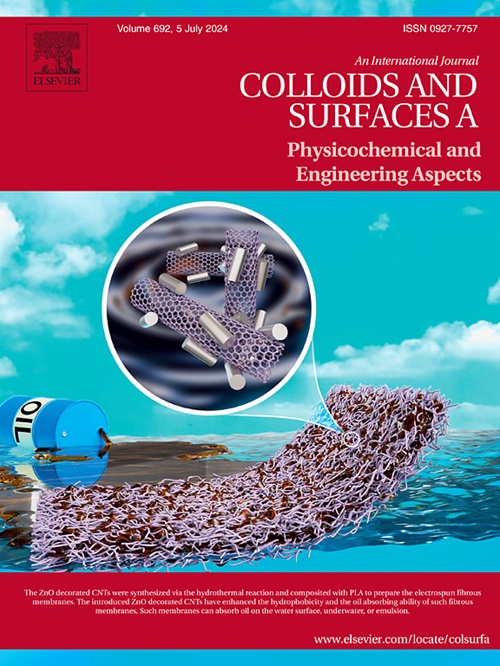氧空位介导的Zn3V2O8/BiVO4型异质结:降解有机染料的高效光催化剂
IF 4.9
2区 化学
Q2 CHEMISTRY, PHYSICAL
Colloids and Surfaces A: Physicochemical and Engineering Aspects
Pub Date : 2025-04-27
DOI:10.1016/j.colsurfa.2025.137057
引用次数: 0
摘要
构建空位介导的异质结已被证明是提高光催化活性的有效策略。因此,在本研究中,我们利用水热方法在不同摩尔比下制备了氧空位介导的Zn3V2O8/BiVO4异质结。Zn3V2O8/BiVO4(2:1)在可见光和太阳照射下对刚果红(CR)染料具有良好的光催化活性。光致发光(PL)分析证实了电子-空穴对异质结复合的减少。x射线光电子能谱(XPS)和电子顺磁共振(EPR)结果表明制备的样品中存在氧空位。Zn3V2O8/BiVO4(2:1)对CR染料的降解效率最高,在可见光和阳光直射下分别在120 min内达到83.7 %和95.03 %,降解速率常数均高于纯Zn3V2O8和BiVO4。提高光催化活性可能是由于减少了电子-空穴对的复合,较大的表面积和氧空位的存在。此外,我们还研究了催化剂用量、染料浓度和不同水基质对Zn3V2O8/BiVO4异质结光催化活性的影响。自由基捕获实验证实了•O2−在CR染料光催化降解中起主要作用。基于观察结果和能带位置的排列,提出了一种合理的空位介导的i型电荷转移机制来解释光催化活性的增强。再循环实验表明,合成的异质结具有较高的稳定性。这项工作强调了氧空位在提高光催化活性中的作用。本文章由计算机程序翻译,如有差异,请以英文原文为准。
Oxygen vacancy mediated Zn3V2O8/BiVO4 type-I heterojunction: An efficient photocatalyst for the degradation of organic dye
Constructing vacancy-mediated heterojunction has proven to be a useful strategy for improving photocatalytic activity. Therefore, in this work, we have developed oxygen vacancy mediated Zn3V2O8/BiVO4 heterojunction at different molar ratios by using the hydrothermal method. The hierarchical Zn3V2O8/BiVO4 (2:1) shows well-crafted heterostructure formation with excellent photocatalytic activity under visible light and solar irradiation against congo red (CR) dye. Photoluminescence (PL) analysis confirmed the reduction of electron-hole pairs recombination of heterojunctions. X-ray Photoelectron Spectroscopy (XPS) and Electron Paramagnetic Resonance (EPR) results demonstrated the existence of oxygen vacancies in the prepared samples. The Zn3V2O8/BiVO4 (2:1) exhibited the highest efficiency, achieving 83.7 % and 95.03 % degradation of CR dye within 120 minutes under visible light and direct sunlight, respectively and the rate constant was faster than those of both pure Zn3V2O8 and BiVO4. The boosted photocatalytic activity can be the result of reduced recombination of electron-hole pairs, large surface area, and the presence of oxygen vacancies. Additionally, we investigated the effect of catalyst dosage, dye concentration, and different water matrices on the photocatalytic activity of Zn3V2O8/BiVO4 heterojunction. The radical trapping experiment confirmed that • played a main role in the photocatalytic degradation of CR dye. Based on the observed results and alignment of band positions, a plausible vacancy-mediated type-I charge transfer mechanism is proposed to explain the enhanced photocatalytic activity. Furthermore, the recycling experiment revealed that the synthesized heterojunction is highly stable. This work highlights the role of oxygen vacancies in enhancing photocatalytic activity.
求助全文
通过发布文献求助,成功后即可免费获取论文全文。
去求助
来源期刊
CiteScore
8.70
自引率
9.60%
发文量
2421
审稿时长
56 days
期刊介绍:
Colloids and Surfaces A: Physicochemical and Engineering Aspects is an international journal devoted to the science underlying applications of colloids and interfacial phenomena.
The journal aims at publishing high quality research papers featuring new materials or new insights into the role of colloid and interface science in (for example) food, energy, minerals processing, pharmaceuticals or the environment.

 求助内容:
求助内容: 应助结果提醒方式:
应助结果提醒方式:


